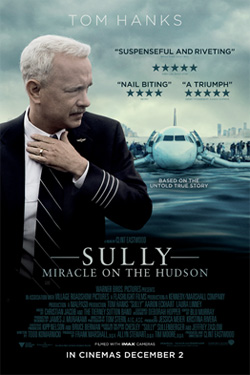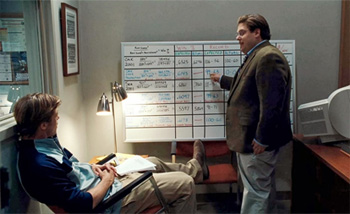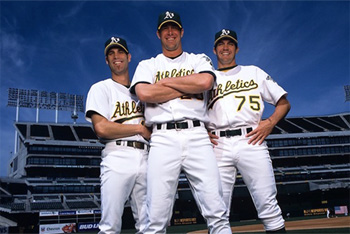5 'Underdog' Movies About Real People Who Weren't Underdogs

The world needs underdog stories -- it's what gives us the irrational hope we need to get through another day of having customers blame us for the milkshake machine being broken again. It's even better when these stories are based on true events. Real people can be heroes, too! The problem is that Hollywood can never be satisfied with the facts. They always have to tweak that shit to make it a little more inspiring. Or, you know, invent all of the most important details out of whole cloth ...
Sully: The "Investigation" Of Sully's Crash Was Routine, And His Conduct Was Never In Doubt
The Hollywood Version:
When U.S. Airways Flight 1549 experiences engine failure due to midair collisions with a bunch of almost certainly drunk geese, Captain Chesley B. "Why Is My Name Chesley, I Thought My Parents Respected Me?" Sullenberger (played by Tom Hanks) is forced to make a landing in New York City's Hudson River. The event becomes known as the Miracle on the Hudson, because against all odds, nobody was killed or even significantly injured, despite being onboard a plane that literally fell out of the fucking sky.
Without Sully's calm quick thinking and general Hanksian go-gettitude, it would've been called the Horror on the Hudson, and the geese would've faced criminal charges.

So why is Sully an "underdog?" Well, as we see in the film, the bureaucrats at the National Transportation Safety Board decide to badger him with accusatory questions, casting doubt on whether he endangered the lives of his passengers by making a hasty decision. They assert that he could've simply landed the plane at a nearby airstrip or whatever. Despite Sully's assurance that he would have crashed if he'd attempted any other kind of landing, the arrogant bullies at the NSTB refuse to believe him, and mostly work to cover their own asses.

Ultimately, after countless interrogations and failed attempts to prove their version of events with simulations of the scenario flown by other pilots, the NTSB is forced to admit that Sully is the best damn pilot since the Rocketeer, and that he made the right call in deciding to land his plane on a river. The little guy triumphs over the evil bureaucracy!
The Reality:
How confrontational were the real inquiries into the Miracle on the Hudson? Well, to answer that question, here's a bunch of those heartless aviation industry suits giving Sully and his co-pilot a standing ovation:

The NTSB was always on Sully's side. His decision was never really challenged, and was generally taken at face value. And while in the movie the NTSB's questioning causes Sully to doubt himself, Sullenberger notes in his memoir that he was "buoyed by the fact that investigators determined that Jeff and I made appropriate choices at every step." In other words, the board put his mind at ease over the incident.
It's true that Sully and his co-pilot were questioned at great length for about 18 months, but those questionings are standard procedure after any plane crash, and the NTSB was trying to use this particular incident to come up with new safety regulations to ensure that this kind of thing wouldn't happen again. (We assume they have begun outfitting all commercial aircraft with manned geese-destroying turrets.) The NTSB was unanimous in agreeing that Sully made the right choice that day, although there was probably some dissent when they voted on whether Sully made the right call when selling his story to Clint Eastwood.
Moneyball: The "Struggling" Baseball Team Was Loaded With Superstars
The Hollywood Version:
Billy Beane (Brad Pitt), the general manager of the dirt-poor Oakland A's, is struggling with the double whammy of coming off a big loss to the New York Yankees and seeing his best talent going elsewhere, which tends to happen after a big loss to the New York Yankees. Facing the prospect of another crap season, Beane has to find a way to put together a winning team out of the ragtag scraps that remain. Enter Peter Brand (Jonah Hill), an economics major who creates a revolutionary new method to recruit better players using numbers and statistics. This nerd magic is known as "sabermetrics."

After a brief adjustment period and some difficulty getting the rest of the A's leadership on board, this little team starts to stack wins at a crazy rate, even making it to the postseason. Although the A's ultimately don't make it to the World Series, Beane decides to stick with them, having proved his controversial method a resounding success.
The Reality:
If you don't know much about baseball, the game is mostly pitching -- the other team can't win if they can't score. And while Beane's system was cool and all, equations and statistical analyses can't physically go out and throw balls at a hundred miles an hour for you. That's why the A's had these guys:

At the same time that Beane and Paul DePodesta (the real version of Peter Brand) were putting together sabermetrics, the A's happened to have three superstar starting pitchers named Tim Hudson, Barry Zito, and Mark Mulder. If you don't remember who played them in Moneyball, that's because they weren't in the movie at all. In the real 2002 season, though, they were utterly dominant. They each pitched over 200 innings and allowed around three runs every nine innings -- meaning that most of the MLB players who stepped to these guys were getting paid to strike out a bunch. They were good at baseball, is our point, and would have made the team competitive even if they had the cast of the movie trying to drive in runs for their side.

Zito even won the Cy Young Award for being the best goddamned pitcher in the American League. Oh, and this scrappy underdog roster also had the league's Most Valuable Player in Miguel Tejada, and their third baseman was an all-star. So that might have had something to do with this team winning a whole bunch. Also, they had finished first or second in their division the three previous years. These guys weren't exactly the misfits from Major League. They were a franchise stacked with good players, though they had recently lost a few of them.
Unfortunately, Beane's revolutionary new sabermetrics system eventually led him to trade Hudson, Zito, and Mulder away, and the universe has been unkind to Oakland baseball ever since.
Unstoppable: The "Unstoppable" Train Was Traveling At Ten Miles Per Hour
The Hollywood Version:
When a train filled with dangerous flammable chemicals goes rogue with no one at the controls, a nail-biting race against time ensues to put the brakes on it before it crashes into a nearby town and turns it into a flaming wasteland of horror.

It's Die Hard on a bus ... on a train.
The train violently resists any attempt to stop it, even killing an engineer in the process. Eventually, the '80s cop movie team of misfits -- soon-to-be-retired veteran Denzel Washington and troubled new recruit Chris Pine -- catch up with the train and are able to stop it minutes before it splatters chemical death everywhere. Thanks to these two nobodies rising to the occasion (overcoming threats of being fired for disobeying orders), everybody lives happily ever after. Except for the dumbass who let the train get loose, who ends up flipping burgers for the rest of his days, because no hamburger has ever barreled out of control into a town and killed everyone within.
The Reality:
The event this movie is based on, the CSX 8888/Crazy Eights incident, was a lot more dull than the movie or even the name would imply. A train carrying dangerous flammable chemicals did get loose, but there were no injuries (much less any deaths), no innocent towns or civilians were in danger, and the whole thing was wrapped up in two hours. In other words, it took less time to resolve the real-life situation than it does to watch the movie it inspired.
Now, senior engineer Jon Hosfield did have to jump onto the moving train to shut it down, but the machine was going a non-pants-shittingly ten miles an hour. That's about the same level of risk that people take riding in the beds of pickup trucks.

Also, whoever was responsible for the incident was never publicly named or judiciously exiled to dollar burger hell, and whatever happened to them was settled internally. All in all, Hollywood took a mistake that was fixed with no problems and turned it into a massive high-stakes drama. It's like if The French Connection had been based on a clerical error on a tax form that was quickly cleared up.
Joy: The Real Joy Didn't Have To Quit College And Never Had A Traitorous Sister
The Hollywood Version:
Aspiring business major Joy Mangano, played by Jennifer Lawrence, has to throw away her education to hold together her dysfunctional family. One day, after slicing her hand to ribbons trying to mop up glass, she hits on the idea for the self-wringing Miracle Mop, which turns out to be the product housekeepers everywhere had been dreaming of (second only to the dream in which they no longer have to work as housekeepers).

However, Joy's road to cleaning product dominance isn't quick and effortless. First and foremost in her way is her evil half-sister Peggy, who constantly belittles her and and tries to steal her company out from under her. (And indeed, who among us can say that we haven't had a sibling attempt to steal our fortune?) Meanwhile, her mom has given up on life in favor of watching soap operas all day, and her dad is played by Robert De Niro, so you know there's a lot of drunken, wordless yelling in this household. Joy somehow manages to keep her family from falling apart and from destroying her business, while also meeting the insane demands of the QVC network. Her hard work pays off, and she becomes an entrepreneur worth millions.

The Reality:
Joy Mangano did have a pretty rough hill to climb, but she had something to help her: a degree in business administration, since she had finished her education. Also, remember the moment in which QVC suddenly asks this overwhelmed single mother to produce 50,000 copies of the Miracle Mop in one week? In reality, she persuaded them to make the order, and it was only for a thousand mops. And the scene when she first goes on TV, gets stage fright, and almost botches it? The real Joy got up there and sold 18,000 mops in 20 minutes. She was a mop-selling Terminator, sent from the future to destroy our mop-less past.

But all that stuff about her family had to be true, right? Yeah, about that: Peggy, Joy's terrible sister, was pulled completely out of director David O. Russell's ass, while her Days Of Our Lives-addicted mother was "made up, a composite of several people." We assume that at least one of the people in that composite was Joy's actual mother, so that's not technically as bad as inventing a family member out of nothing, but real-life Joy's father doesn't look a thing like De Niro, so we don't know what to believe anymore.
The Blind Side: Michael Oher Had Been Playing Football For Years Before He Ever Met Leigh Anne Tuohy
The Hollywood Version:
The Blind Side stars Sandra Bullock as Leigh Anne Tuohy, a Texas housewife who takes in a homeless black teenager named Michael Oher. Oher begins attending the local private school, where coaches recognize his potential as an offensive lineman for their football team (this is another way of saying that they notice he is a giant).
The only problem is that Oher is a meek, gentle kid, reluctant to use his strength even to block for his quarterback. He's basically Ferdinand the Bull, and to reiterate this, Tuohy reads that exact story to him at one point. The film goes out of its way to make it very clear that Oher has a hard time understanding the game of football, period.

One day, noticing Oher's sensitive struggles, Tuohy heads out onto the practice field and explains to Oher in front of everybody that the football team is like his family, and as such, he needs to protect them. Realizing that blocking in football is as simple as pretending your quarterback is your mother (a similar lesson to the one taught by The Waterboy, another timeless football film), Oher proceeds to absolutely dominate the game, eventually going all the way to an NFL career and a Super Bowl win.
The Reality:
The real Michael Oher was playing varsity football by the time he was an eighth-grader, well before he met Tuohy, and he didn't love seeing a movie that portrayed him as a gigantic dummy who couldn't wrap his head around the game until the heroically white Sandra Bullock explained it to him. According to an interview, the idea that he would need to be taught how to play football at all "really got to because it was never like that. always known how to play the game of football."
In fact, the most difficulty Oher faced playing football didn't occur until after The Blind Side came out, when he became a novelty to be cheered and booed in equal measure. So while Tuohy and her family did adopt Oher, at no point did the task of teaching him how to unlock his superior athleticism (Oher played basketball and ran track in school as well) fall to her. That's just nonsense, Miss Congeniality.
Sam Jackson prays that his eventual biopic leaves out the thing involving Daniel Radcliffe and the truck of llamas. Follow him on Facebook or Twitter. Jordan Breeding is a part-time writer, a full-time lover, and an all-the-time guitarist. Check out his band at http://www.skywardband.com or on Spotify here.
For more movies where Hollywood took a little creative liberty here and there, check out 6 Movies Based On A True Story That Left Out Important Stuff and 6 Movies Based On A True Story (That Are Also Full Of Shit).
Subscribe to our YouTube channel, and check out The Awful Truth About Movies 'Based On A True Story,' and other videos you won't see on the site!
Follow us on Facebook, and we'll tell terrible lies about you to everyone we know.
